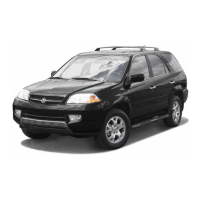If you check the pressure when the
tires are hot [driven for several miles
(kilometers)], you will see readings 4
to6psi(30to40kPa,0.3to0.4
kgf/cm ) higher than the cold
reading. This is normal; do not
release air to match the cold
pressure.
Tubeless tires have some ability to
self-seal if they are punctured. You
should look closely for punctures if a
tire starts losing pressure.
Youshouldgetyourowntire
pressure gauge and use it whenever
you check your tire pressures. This
will make it easier for you to tell if a
pressure loss is due to a tire problem
and not due to a variation between
gauges.
Thecompactsparetirepressureis:
For convenience, the recommended
tire sizes and cold air pressures are
on a label on the driver’s doorjamb.
For additional technical information
about your tires, see page .
Every time you check inflation, you
should also examine the tires for
damage, foreign objects, and wear.
Youshouldlookfor:
Bumps or bulges in the tread or
side of the tire. Replace the tire if
youfindeitherortheseconditions.
Cuts, splits, or cracks in the side
of the tire. Replace the tire if you
can see fabric or cord.
Excessive tread wear.
Tire pressure for high speed driving
is the same as for normal driving.
256
Tire Size Cold Tire Pressure
for Normal Driving
Tires
Maintenance
Inspection
222
60 psi (420 kPa , 4.2 kgf/cm )
P235/65R17 103T 32 psi (220 kPa , 2.2
kgf/cm
)

